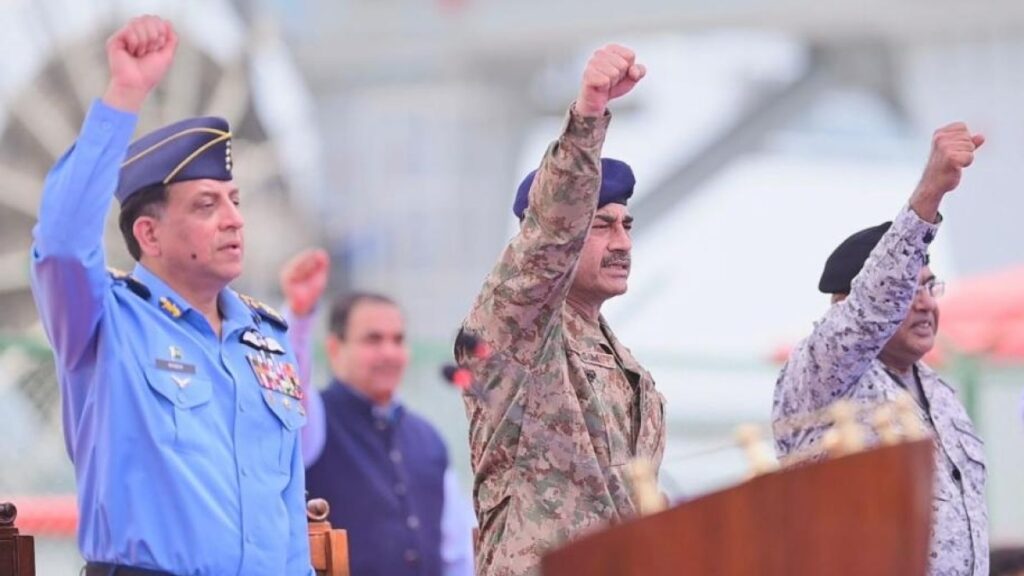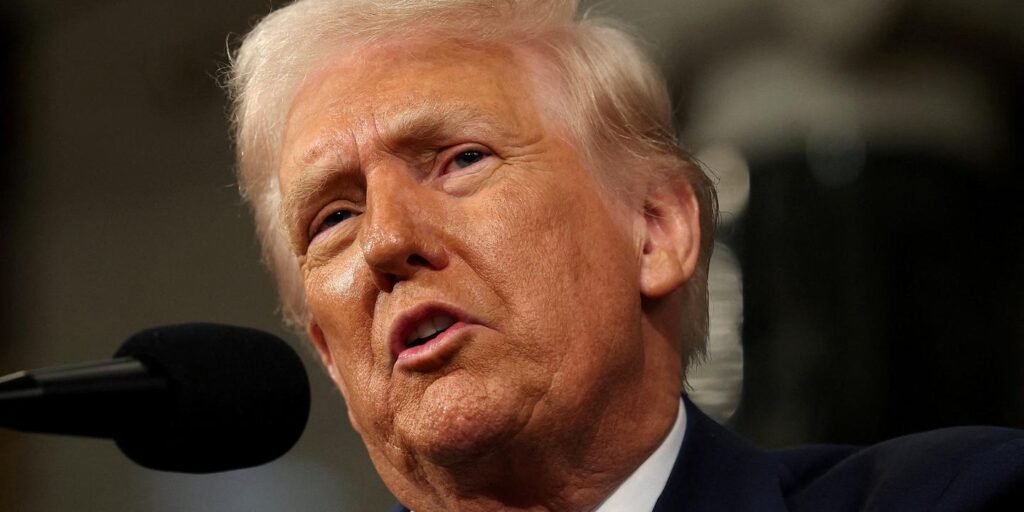Islamabad, Pakistan – Pakistan has codified the most ambitious restructure of its military and judiciary in decades after President Asif Ali Zardari signed his assent to ratify the country’s 27th Constitutional Amendment on Thursday.
The amendment, which passed in both houses of parliament earlier in the week amid opposition protests and criticism from a range of civil society activists and sitting judges, makes major changes to Pakistan’s higher judiciary.
Recommended Stories
list of 4 itemsend of list
But many analysts believe that its most consequential feature is a sweeping overhaul of Article 243, the constitutional clause defining the relationship between Pakistan’s civilian government and the military.
The changes grant lifetime immunity from criminal prosecution to the country’s top military leaders, significantly reshape the military’s command structure, and further tilt the balance of the tri-services – the army, navy and air force – heavily in the army’s favour.
Analysts warn that this contentious reform risks colliding with entrenched institutional cultures and could rock the country’s fragile civilian–military equilibrium.
Al Jazeera has sought comment from the military’s media wing on the changes and the debate over them, but has received no response.
A new command structure
The revised Article 243 establishes a new post, the Chief of Defence Forces (CDF), to be held concurrently by the Chief of Army Staff (COAS). This effectively gives the army chief command authority over the Pakistan Air Force (PAF) and Pakistan Navy (PN).
The incumbent COAS is Field Marshal Asim Munir, who assumed command in November 2022 and was elevated to a five-star rank on May 20 this year, just 10 days after Pakistan ended its four-day conflict with India.
Munir became only the second Pakistani military officer – after Field Marshal Ayub Khan in the 1960s – to receive the five-star designation. The air force and navy have never had a five-star official so far.
The amendment also abolishes the office of Chairman Joint Chiefs of Staff Committee (CJCSC) at the end of this month. The role is currently held by four-star General Sahir Shamshad Mirza, who retires on November 27. Another major change is the creation of the Commander of the National Strategic Command (CNSC), a post overseeing Pakistan’s nuclear command. The position will be limited to only an army officer, appointed in consultation with the CDF, with a three-year term extendable by another three years.
The amendment effectively transforms five-star titles from what were honorary recognitions into constitutionally recognised offices with expansive privileges.
Under the new arrangement, five-star officers will enjoy lifetime immunity from criminal prosecution and will “retain rank, privileges and remain in uniform for life.”
Removing a five-star officer will require a two-thirds parliamentary majority, whereas an elected government can be dismissed by a simple majority.
“While government spokespersons refer to these titles as ‘honorary’, given to ‘national heroes’ to celebrate their services,” Reema Omer, a constitutional law expert, said, the amendment “implies actual power, not just honorary significance”.
Omer told Al Jazeera that lifelong immunity from criminal proceedings was “concerning from a rule of law perspective”.
A former three-star general, speaking on condition of anonymity, acknowledged that the changes appeared to be “meant to consolidate” the army chief’s power.
Hours after the president’s ratification on Thursday evening, Pakistan’s government brought amendments to the laws governing the three services.
Under the revised Army Act, the clock on the tenure of the army chief will now restart from the date of his notification as CDF.
Last year, parliament had increased the tenure of the service chiefs from three to five years, which meant Munir’s term would run until 2027. Following the new changes, it will now extend even further. Once the revised rules take effect at the end of this month, Munir will hold both posts – COAS and CDF – at least until November 2030.

Military dominance – and the role of the India conflict
Since independence in 1947, Pakistan’s military, especially the army, has been the most powerful institution in national life.
Four coups and decades of direct rule have been accompanied by significant influence, even when civilian governments have been in power. The army chief has long been widely viewed as the country’s most powerful figure.
No prime minister has ever completed a full five-year term, while three of four military rulers have governed for more than nine years each.
General Qamar Javed Bajwa, Munir’s predecessor, acknowledged this history in his farewell address in November 2022, conceding that the military had interfered in politics for decades, and promising to break with that legacy.
But three years later, rights groups and opposition parties allege that little has changed, and some claim that the military has further strengthened its grip over state institutions.
The military restructure under the 27th Amendment also comes six months after Pakistan’s brief conflict with India in May, raising questions over whether the reforms were linked to that fight.
Aqil Shah, professor of international affairs at Georgetown University in Washington, DC, argued that the confrontation with India created the opening for this “unprecedented role expansion” for the army chief.
The changes “formalise the army’s de facto hegemony over the other two wings of armed forces in the guise of the ‘unity of command’ as a necessity for war fighting,” Shah told Al Jazeera.
But supporters of the amendment disagree. Aqeel Malik, state minister for law and justice, said that the amendment aims to “plug holes” in Pakistan’s national security architecture.
“The amendment granted constitutional cover to defence integration and improved coordination. We have also provided a constitutional cover to the honour bestowed upon our national heroes and have addressed a long overdue cohesive and better coordination within the forces for a swift response,” Malik said.
Ahmed Saeed, a former vice admiral, similarly described the reform as a “forward-looking institutional change”.
He said the conflict with India exposed that Pakistan’s command model was rooted in a 1970s framework, unsuitable for “multi-domain, hybrid warfare of the 21st century”.
“The amendment is not about ‘fixing what is broken’ but about modernising what is functioning to ensure sustained effectiveness in future contingencies,” Saeed told Al Jazeera.
Fears of imbalance
Other critics, including former senior officials and security analysts, believe the amendment is less about modernisation and more about institutional consolidation.
They argue that creating the CDF post cements the army’s dominance over the other branches.
Many question why the command structure should be overhauled when, by the government’s own narrative, the existing system delivered what Pakistan claims was an “outright victory” against India.
A retired three-star general who served in senior roles before retiring in 2019 said the abolished CJCSC role, despite being largely symbolic, provided a mechanism for balancing perspectives across the army, navy and air force.
“The PAF and PN may lose autonomy in strategic planning and most probably senior promotions, which has the potential to breed resentment,” he said.
“These risks institutional imbalance, undermining the very cohesion the amendment claims to enhance,” the former general added.
The CJCSC – a four-star post and the principal military adviser to the prime minister – can theoretically be filled by any service, but the last non-army officer to hold the position was Air Chief Marshal Feroz Khan in 1997.
Security analyst Majid Nizami said that while the amendment aims to codify five-star ranks, it may create challenges for “cohesion and synergy” among the services.
If the goal was to modernise warfare strategy, he argued, there should have been a dedicated officer focused solely on integration, not the army chief assuming dual authority.
“There is a lack of clarity on rules and terms of reference for the CDF,” Nizami said.
Shah, the Georgetown academic and author of The Army and Democracy, said the amendment “formalises the de facto power” of the COAS over the other branches.
Saeed, the former navy official who retired in 2022, however, disagreed with critics, arguing that the amendment simply clarifies the CDF’s strategic coordination role.
“The amendment retains the PAF and PN’s distinct command structures within their domains of responsibility, and the CDF’s function is limited to integration at the strategic level, not administrative control or operational interference,” he said.
He added that claims of “army dominance” stem from “legacy perceptions, not from constitutional reality.”
Control of nuclear command
The amendment also codifies the army’s control of Pakistan’s nuclear programme, including research, development and deployment, responsibilities that fall under the strategic command structure.
The former three-star general who spoke to Al Jazeera said the new system’s operational details remain unclear. Under the current model, the Strategic Plans Division (SPD) manages Pakistan’s ballistic and cruise missile programmes and nuclear assets.
Nizami said that although the CJCSC nominally oversaw the SPD, operational authority has long rested with the army. The amendment now formalises this reality.
Saeed, however, countered by arguing that in effect, even with the changes, “the entire nuclear enterprise operates under civilian-led oversight with constitutional clarity”.
Political fallout
Critics have described the amendment as a “constitutional surrender” by political parties to the military, and an attempt to institutionalise the “supremacy of the uniform over the ballot”.

It also comes at a time when Field Marshal Munir’s public profile has risen significantly. He has undertaken multiple foreign trips, including several to the United States, and has been described by President Donald Trump as his “favourite field marshal”.
Meanwhile, former Prime Minister Imran Khan, jailed for the past two years, accuses Munir of orchestrating the crackdown on him and his party, Pakistan Tehreek-e-Insaf (PTI), since their ouster in 2022 through a no-confidence vote – a charge that the military has rejected outright.
In Pakistan’s February 2024 election, the PTI was barred from contesting as a party. But its candidates, contesting independently, secured the most seats even though they failed to secure a majority. Instead, the Pakistan Muslim League-Nawaz (PML-N) of Prime Minister Shehbaz Sharif formed the government with allies. The government and military rejected widespread accusations of election rigging.
Shah argued that the political class supported the amendment out of necessity.
“Lacking democratic legitimacy and faced with the political challenge posed by the PTI and Khan, the ruling PML-N government sees Munir as the key guarantor of their power and political interests,” he said.
Nizami, the Lahore-based analyst, meanwhile, said that separate appointments to the posts of the CDF and the army chief would have made more sense if the intent was to strengthen the military structure and balance. The amendment, he warned, could lead to “institutional imbalance instead of institutional synergy”.


